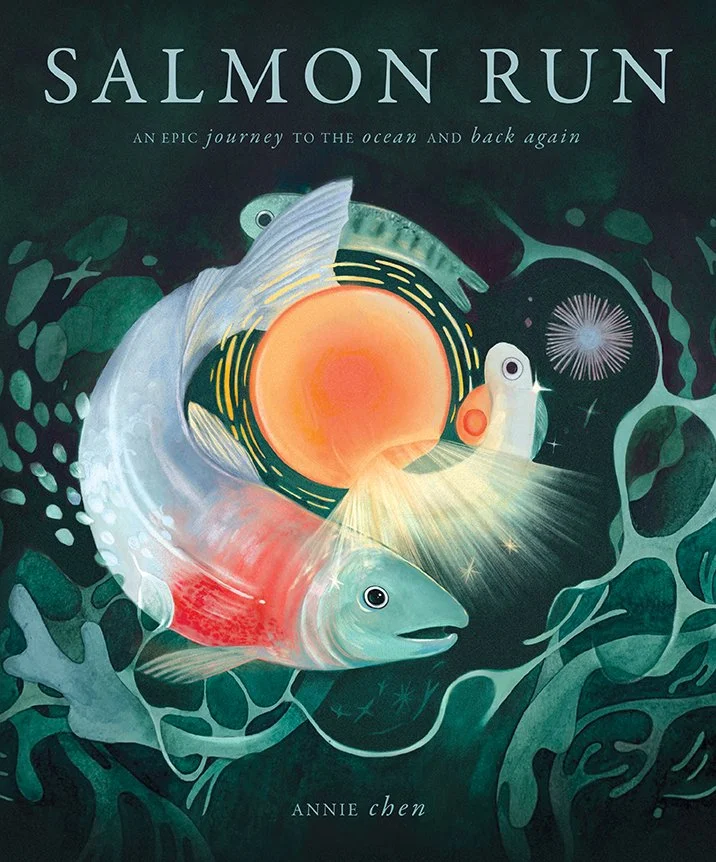
SALMON RUN
Additional Backmatter
Finding Home Despite the Odds
Although scientists still don’t fully understand how salmon navigate the vast ocean, they believe these remarkable fish use a combination of their strong sense of smell and Earth's magnetic fields to find their way back to their home rivers.
During their early stages of life in freshwater rivers and streams, they will imprint on (learn and remember) the smells and chemical makeup of their environments. Just as the familiar scents of your home or neighborhood — like the aroma of your family’s cooking, the earthy smell of trees outside, or the sweet fragrance of freshly baked cookies— can remind you of home, a salmon too carries the memory of the unique scent of its home river.
As salmon journey further from their home stream towards the ocean, the smells that they have imprinted on become too faint to detect, and they must rely on a different method to find their way around. Salmon have a special ability to sense small changes in Earth’s magnetic field, an invisible force created by the movement of molten iron in the Earth's core. This force wraps around earth and even into space, and is the same force that tells your compass to point north! While they’re out in the open ocean, salmon rely on the Earth's magnetic field like a built-in compass, which helps them orient themselves and find their way toward their home rivers. As they get closer, their scent memory kicks in, guiding them to the exact area where they were born.
A Keystone Species
Salmon are a keystone species in the Pacific Northwest, which means their role is so important that their absence would completely change the ecosystem. Salmon have an important part to play as both predators and prey in the ecosystem, and support an entire web of life around them. Young salmon feed on insects and small organisms in freshwater streams, while adult salmon provide food for many animals, including bears, eagles, and other predators. When salmon die after spawning, their bodies release important nutrients into the soil and water, helping plants, insects, and other creatures thrive. Without salmon, many species would struggle to survive, and entire ecosystems would change dramatically! The true heart of the Pacific Northwest, Salmon are a crucial part of nature’s balance--connecting land, water, and wildlife in a way that no other species can.
Glossary
Alevin: A baby salmon that has just hatched from its egg; it still has a yolk sac attached to its belly for food.
Arduous: Something that is very hard or takes a lot of effort. For example, swimming upstream to lay eggs is an arduous journey for salmon.
Camouflage: A way of blending in with the surroundings to hide from danger. Many animals, like fish, have colors or patterns that help them stay safe and unseen in their environment.
Duwamish River: The lower 12 miles of the Green River, located in the state of Washington. This river is named after the Duwamish Tribe, the indigenous people of metropolitan Seattle, who have lived in the region for thousands of years.
Embryo: The early stage of a baby salmon's life, before it is born or hatches from an egg.
Estuary: A special body of water that sits between the river and the ocean, and is made up of both freshwater and saltwater.
Fry: A young salmon that has used up its yolk sac and is starting to swim and eat on its own.
Freshwater: Water that is not salty, like in lakes, rivers, and streams, where fish and animals live and drink.
Membrane: A thin, stretchy layer that covers or protects something, like the skin of an egg or the outside of a fish’s body.
Nutrients: The things that living creatures need to grow, stay healthy, and have energy, like food or special vitamins.
Pacific Northwest: A region in the Northwestern United States that borders the Pacific Ocean, and includes the states of Oregon, Washington, and part of Idaho.
Pacific Ocean: The largest ocean in the world, located between Asia and the Americas. Salmon swim in the Pacific Ocean when they grow up.
Plankton: Tiny plants and animals that float in the water. Many fish, including salmon, eat plankton when they are young.
Puget Sound: A large body of water in Washington state, where freshwater rivers mix with the salty water of the Pacific Ocean. Many salmon live and travel through here.
Redd: A special nest that salmon make in the gravel at the bottom of rivers to lay their eggs.
Saltwater: Water that contains salt, like the water in oceans and seas. Many sea animals, like fish and whales, live in saltwater.
Smolting: The process when young salmon change their bodies to get ready for life in the ocean. During smolting, their scales and color change, and their body adapts to swim in saltwater. This helps them survive when they leave the river and enter the sea.
Washington: A state in the far northwest corner of the United States. Bordering the Pacific Ocean, it is home to tall mountains and green forests.
Yolk: The yellow part of an egg that gives the baby fish or animal nutrients to grow before it hatches.

